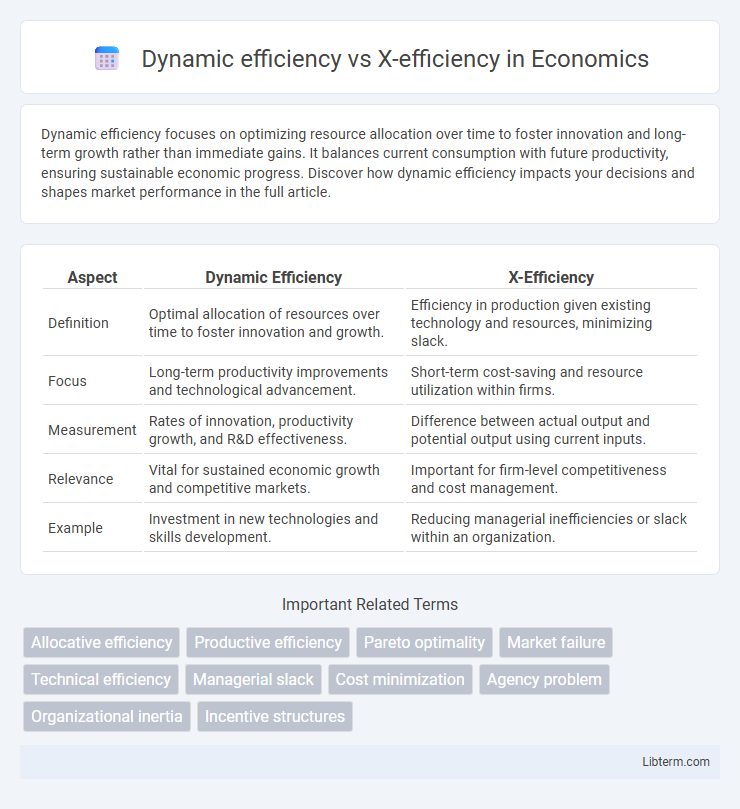Dynamic efficiency focuses on optimizing resource allocation over time to foster innovation and long-term growth rather than immediate gains. It balances current consumption with future productivity, ensuring sustainable economic progress. Discover how dynamic efficiency impacts your decisions and shapes market performance in the full article.
Table of Comparison
| Aspect | Dynamic Efficiency | X-Efficiency |
|---|---|---|
| Definition | Optimal allocation of resources over time to foster innovation and growth. | Efficiency in production given existing technology and resources, minimizing slack. |
| Focus | Long-term productivity improvements and technological advancement. | Short-term cost-saving and resource utilization within firms. |
| Measurement | Rates of innovation, productivity growth, and R&D effectiveness. | Difference between actual output and potential output using current inputs. |
| Relevance | Vital for sustained economic growth and competitive markets. | Important for firm-level competitiveness and cost management. |
| Example | Investment in new technologies and skills development. | Reducing managerial inefficiencies or slack within an organization. |
Introduction to Economic Efficiency
Dynamic efficiency involves the optimal allocation of resources over time, emphasizing innovation and technological progress to enhance productivity and economic growth. X-efficiency measures the degree to which firms minimize cost and waste given existing technologies, highlighting inefficiencies within organizations that hinder optimal performance. Understanding these concepts is crucial for analyzing how economies can improve resource use both in the short run through organizational efficiency and in the long run via innovation.
Defining Dynamic Efficiency
Dynamic efficiency refers to the optimal allocation of resources over time, emphasizing innovation, technological progress, and long-term growth rather than immediate cost minimization. It measures how effectively firms invest in research and development, adapt to market changes, and improve productivity to sustain competitive advantage. Unlike X-efficiency, which focuses on minimizing inefficiencies within existing processes, dynamic efficiency prioritizes continuous improvement and the evolution of economic systems.
Understanding X-Efficiency
X-efficiency measures how effectively firms utilize resources under existing market conditions, highlighting inefficiencies caused by lack of competitive pressure or managerial slack. Dynamic efficiency focuses on innovation and investment over time to improve processes and products, driving long-term economic growth. Understanding X-efficiency helps identify gaps in operational performance that do not stem from technological progress but from internal organizational weaknesses.
Key Differences: Dynamic vs X-Efficiency
Dynamic efficiency emphasizes long-term improvements through innovation, technological advancement, and investment in research and development, driving sustained economic growth. X-efficiency focuses on internal operational efficiency, minimizing waste and maximizing output from existing resources within firms at a given point in time. While dynamic efficiency relates to adapting and evolving processes over time, X-efficiency centers on optimizing current performance by reducing inefficiencies and slack.
The Role of Innovation in Dynamic Efficiency
Innovation drives dynamic efficiency by enabling firms to improve production processes and develop new products over time, increasing overall economic growth. Unlike X-efficiency, which measures operational efficiency within existing resources, dynamic efficiency emphasizes long-term improvements through research and development investments. Technological advancements and innovation cycles are critical in sustaining competitive advantage and fostering productivity improvements central to dynamic efficiency.
Organizational Factors Influencing X-Efficiency
Organizational factors influencing X-efficiency include management practices, employee motivation, and internal communication, which directly affect resource utilization and operational performance. Ineffective leadership and lack of incentives can lead to slack within firms, reducing productivity compared to the optimal dynamic efficiency where resource allocation adapts efficiently over time. Enhancing X-efficiency requires fostering a culture of accountability, innovation, and continuous improvement to minimize organizational inefficiencies and maximize competitive advantage.
Dynamic Efficiency in Competitive Markets
Dynamic efficiency in competitive markets drives innovation and long-term productivity by encouraging firms to invest in research and development and adopt new technologies. It ensures optimal resource allocation over time, balancing cost reduction with quality improvement and market expansion. Contrastingly, X-efficiency highlights internal operational inefficiencies, which dynamic efficiency seeks to minimize through continuous competitive pressure.
Measuring X-Efficiency: Challenges and Methods
Measuring X-efficiency involves assessing an organization's ability to minimize waste and operate closer to its production frontier, which is challenging due to the lack of observable benchmarks and the influence of external factors like market conditions. Methods such as Data Envelopment Analysis (DEA) and Stochastic Frontier Analysis (SFA) are commonly employed to estimate X-efficiency by comparing input-output ratios across firms while accounting for statistical noise. Accurate measurement requires isolating inefficiency from random errors and recognizing that organizational behaviors and managerial capabilities significantly impact X-efficiency.
Policy Implications for Efficiency Improvement
Dynamic efficiency emphasizes innovation and long-term productivity growth, urging policies that foster research and development, technology adoption, and human capital enhancement. X-efficiency highlights reducing internal inefficiencies such as managerial slack and resource misallocation, recommending policies that improve organizational incentives, competitive pressures, and regulatory frameworks. Policymakers should balance fostering a competitive environment to drive X-efficiency while investing in innovation ecosystems to achieve sustained dynamic efficiency improvements.
Conclusion: Balancing Dynamic and X-Efficiency
Balancing dynamic efficiency and X-efficiency requires firms to innovate continuously while minimizing resource wastage in current operations. Emphasizing strategic investment in new technologies enhances dynamic efficiency, whereas improving managerial practices and employee motivation reduces X-inefficiency. Optimal performance is achieved when organizations allocate resources effectively to foster innovation and maintain operational excellence simultaneously.
Dynamic efficiency Infographic

 libterm.com
libterm.com